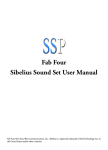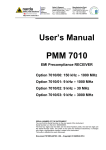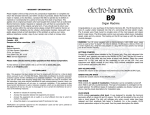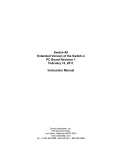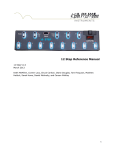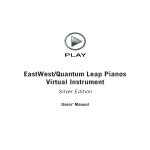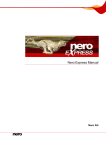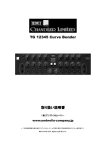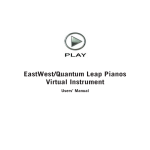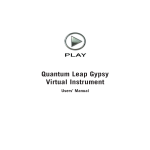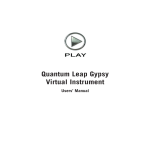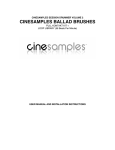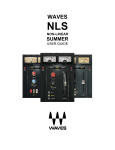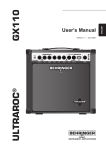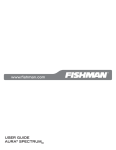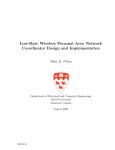Download Fab Four Virtual Instrument Manual
Transcript
Fab Four Virtual Instrument Users’ Manual FAB FOUR VIRTUAL INSTRUMENT The information in this document is subject to change without notice and does not represent a commitment on the part of East West Productions, L.L.C. The software and sounds described in this document are subject to License Agreements and may not be copied to other media. No part of this publication may be copied, reproduced or otherwise transmitted or recorded, for any purpose, without prior written permission by East West Productions, LLC. All product and company names are ™ or ® trademarks of their respective owners. PLAY™ is a trademark of East West Sounds, Inc. © East West Sounds, Inc., 2010. All rights reserved. East West Sounds, Inc. 6000 Sunset Blvd. Hollywood, CA 90028 USA 1-323-957-6969 voice 1-323-957-6966 fax For questions about licensing of products: [email protected] For more general information about products: [email protected] http://support.soundsonline.com Version of July 2010 ii FAB FOUR VIRTUAL INSTRUMENT 1. Welcome 2 Producer: Doug Rogers 4 Engineer: Ken Scott 6Credits 8 How to Use This and the Other Manuals 9 Online Documentation and Other Resources Click on this text to open the Master Navigation Document 1 FAB FOUR VIRTUAL INSTRUMENT Producer: Doug Rogers Doug Rogers has over 30 years experience in the audio industry and is the recipient of many recording industry awards including “Recording Engineer of the Year.” In 2005, “The Art of Digital Music” named him one of “56 Visionary Artists & Insiders” in the book of the same name. In 1988, he founded EastWest, the most critically acclaimed sound developer in the world, and recipient of over 50 industry awards, more than any other sound developer. His uncompromising approach to quality, and innovative ideas have enabled EastWest to lead the sound-ware business for 20 years. In the late eighties, he released the very first commercial drum sample CD, and followed it with the multiple-award-winning “Bob Clearmountain Drums” sample collection. In the years that followed he practically reinvented the sound-ware industry. EastWest introduced loop sample libraries to the market in the early nineties, followed closely by the first midi-driven loops (Dance/Industrial). He released the first sample library to include multiple dynamics, followed by the first sample library to stream from hard disk, an innovation that led to the detailed collections available today. His recent productions of Symphonic Orchestra (awarded a Keyboard Magazine “Key Buy Award,” EQ Magazine “Exceptional Quality Award,” Computer Music Magazine “Performance Award,” and G.A.N.G. [Game Audio Network Guild] “Best Sound Library Award”); and Symphonic Choirs (awarded Electronic Musician “2006 Editor’s Choice Award,” G.A.N.G. “Best Chapter 1: Welcome 2 FAB FOUR VIRTUAL INSTRUMENT Sound Library Award,” and Keyboard Magazine “Key Buy Award”). He persuaded audio legend Prof. Keith O. Johnson to record EWQLSO and EWQLSC, and came up with the revolutionary idea of recording all instruments and voices with 3 simultaneous stereo mic setups so users can control the tone of the performances and the acoustics of the concert hall, as well as create surround sound mixes. His latest productions include Quantum Leap Pianos, another 3 mic setup, and the most detailed virtual piano collection ever produced; and Fab Four, inspired by the sounds of the Beatles, featuring the same kind of vintage instruments and original EMI/Abbey Road recording equipment as the Beatles used to create their music. He persuaded audio legend Ken Scott, who was involved in the recording of five Beatles albums, and engineer for “Magical Mystery Tour” and “The Beatles” (also known as the White Album) to work with him on Fab Four. He also acquired one of Hollywood’s most famous recording studio complexes in 2006, formally United Western (now EastWest Studios), recipient of more engineering awards and RIAA certified Gold and Platinum recordings than any other studios worldwide. He persuaded top international design superstar Philippe Starck to redesign the non-technical areas of the studios. Over the last decade he has partnered with producer/composer Nick Phoenix and set up the Quantum Leap imprint, a subsidiary of EastWest, to produce high-quality, no compromise sample libraries and virtual instruments. EastWest/ Quantum Leap virtual instruments are considered the best available and are in daily use by the who’s who of the industry. His latest technical achievement was unveiled at the 2007 NAMM convention - the world’s first 64-bit audio engine named PLAY, which powers EastWest/Quantum Leap’s latest suite of virtual (software) instruments. Chapter 1: Welcome 3 FAB FOUR VIRTUAL INSTRUMENT Engineer: Ken Scott Throughout his forty years in the recording industry, Ken Scott has had a reputation as being “one of the best.” His start, at the age of 16, came from the world renowned Abbey Road studios where he initially worked in the tape library. Within a very short time he had worked his way up to the position of recording engineer and found himself working with the elite of the popular music world including The Beatles Jeff Beck, Pink Floyd, the Hollies, Procol Harum and many more. Ken’s desire to work with as many types of artists as possible, limited by EMI Records’ ownership of Abbey Road, led him to one of the fastest growing independent studios. At Trident Studios he garnered two Grammy nominations, a Clio award and millions of record sales with such artists as Elton John, George Harrison, Harry Nilsson, the Rolling Stones, and America. The need to grow led Ken to production and more artistic say in the way projects turned out. It was through his knowledge and foresight that artists like David Bowie and Supertramp became superstars, once again leading to millions of sales and still more Grammy nominations. When Frank Zappa brought a band to Ken’s attention, Missing Persons, the decision was made to be their engineer, producer, and manager. Once again expanding Ken’s area of expertise, this time looking after the band’s entire career. The success continued, a first album with sales exceeding 800,000 units, sell out concerts at such Chapter 1: Welcome 4 FAB FOUR VIRTUAL INSTRUMENT places as Long Beach Arena and a performance in front of 190,000 people at the last US Festival. Over the last few years Ken has received still more gold and platinum awards from around the world, with acts such as Level 42 and Duran Duran, as well as working with George Harrison and the George Harrison Estate and broadening his scope with music production for major motion pictures. Ken’s body of work since he started at Abbey Road at 16 speaks for itself: Magical Mystery Tour, The Beatles; Honky Chateau, Elton John; Truth, Jeff Beck; Fog On The Tyne, Lindisfarne; Apples And Oranges, Pink Floyd; The Man Who Sold The World, David Bowie; Lord Sitar, Lord Sitar; Birds Of Fire, Mahavishnu Orchestra; All Things Must Pass, George Harrison; Transformer, Lou Reed; New York City, Al Kooper; America, America; The Beatles, The Beatles; Son Of Schmilsson, Harry Nilsson; Don’t Shoot Me I’m Only The Piano Player, Elton John; Wonderwall, George Harrison; A Salty Dog, Procol Harum; The Radha Krshna Temple, The Radha Krshna Temple; Madman Across The Water, Elton John; Thankyou, Duran Duran; L the P, Scaffold; A Saucerful Of Secrets, Pink Floyd; I’d Like To Teach The World To Sing, The New Seekers; Post Card, Mary Hopkin; S.F.Sorrow, The Pretty Things; The Six Wives Of Henry VIII, Rick Wakeman; Hunky Dory, David Bowie; Night Of The Living Dregs, Dixie Dregs; Young And Rich, The Tubes; Spring Session M, Missing Persons; Crisis, What Crisis?, Supertramp; Schooldays, Stanley Clarke; Crafty Hands, Happy The Man; True Colours, Level 42; The Lost Trident Sessions, Mahavishnu Orchestra; The Rise And Fall Of Ziggy Stardust, David Bowie; Spectrum, Billy Cobham; Inside, Whiteheart; The Witching Hour, Hellion; Crime Of The Century, Supertramp; There And Back, Jeff Beck; What If, Dixie Dregs; Visions Of The Emerald Beyond, Mahavishnu Orchestra; Gamma 1, Gamma; Duty Now For The Future, Devo; Journey To Love, Stanley Clarke; Aladdin Sane, David Bowie; Crosswinds, Billy Cobham; Vinyl Confessions, Kansas; Puzzle, Dada; Pinups, David Bowie; Happy The Man, Happy The Man; Like Children, Jerry Goodman and Jan Hammer; Missing Persons, Missing Persons. Chapter 1: Welcome 5 FAB FOUR VIRTUAL INSTRUMENT Credits Producer Doug Rogers Engineer Ken Scott Assistant Engineer Rhys Moody Musicians Drums: Denny Seiwell, Guitars: Laurence Juber, Keyboards: John Sawoski Production Assistance Nick Phoenix Programming Pacemaker Sound Editing Rhys Moody, Nick Pavey, Justin Harris Art Direction Doug Rogers, Shaun Ellwood Software Sam Fischmann, Klaus Voltmer, Patrick Stinson, Stefan Kersten, Klaus Lebkücher, Toine Diepstraten, Stefan Podell, Albert Ortega, Doug Rogers, Nick Phoenix, Rhys Moody, Stefan Leiste Manual John Philpit Chapter 1: Welcome 6 FAB FOUR VIRTUAL INSTRUMENT Special Thanks to Stefan Leiste, Gary Meyerberg (Swarmandel and for keeping all the old gear going), John Hinson, J.J. Blair, Mark Linett, Jim Elyea, Lon Cohen, Michael Lloyd, Jim Wilson, Brian Kehew and Kevin Ryan (Recording The Beatles), Brian Gibson Strawberry Flutes licensed from Mellotron (www.mellotron.com); Screaming Girls licensed from BBC; Harmonium sampled by Lars Weston; Lowery Organ sampled by David Jacques; Sitar, Hammond B3 sampled by Nick Phoenix Enhanced with Transonics™ EAST WEST PRODUCTIONS, L.L.C. Chapter 1: Welcome 7 FAB FOUR VIRTUAL INSTRUMENT How to Use This and the Other Manuals All documentation for the EastWest PLAY Advanced Sample System and its libraries is provided as a collection of Adobe Acrobat files, also called PDFs. They can be viewed on the computer screen or printed to paper. Each time you install one of the PLAY System libraries, two manuals are copied to the file system on your computer: • The manual that describes the whole PLAY System. This, the largest of the manuals, addresses how to install and use all aspects of the software that are common to all libraries. • The library-specific manual, such as the one you are currently reading. This smaller document describes aspects that differ from one library to the next, such as the list of included instruments and articulations. Using the Adobe Acrobat Features By opening the Bookmarks pane along the left edge of the Adobe Acrobat Reader, the user can jump directly to a topic from the section names. Note that some older versions of Acrobat Reader might not support all these features. The latest Acrobat Reader can be downloaded and installed at no cost from the Adobe web site. (As an example of a hyperlink, you can click on the last word of the previous sentence to be taken directly to the Adobe site.) When reading this and other manuals on the computer screen, you can zoom in to see more detail in the images or zoom out to see more of the page at once. If an included picture of the user interface, or a diagram, seems fuzzy or illegible, then zoom in using one of several means provided in the Acrobat Reader software. The Master Navigation Document Because the EastWest PLAY System is a collection of components, each with its own User’s Manual, a Master Navigation Document (MND) is provided to allow users to jump quickly between these PDFs when being read on the computer screen. This MND is a one-page file with hyperlinks to the PLAY System documentation and to all the library manuals. Hyperlinks to this Master Navigation Document are found on the title page of each chapter in each document. From there, you can open any other document in the collection. For example, if you’re reading something in this documentation for the EastWest Fab Four library, and need to open the manual for the PLAY System as well, go to any chapter title page and click on the link that says, “Click on this text to open the Master Navigation Document.” It will open in a new window on the screen. In that document, click on the icon for the PLAY System and its manual will open in the same window (hiding the MND). You now have both the Fab Four library manual and the PLAY System manual open in separate windows so you can refer to them both. Chapter 1: Welcome 8 FAB FOUR VIRTUAL INSTRUMENT Online Documentation and Other Resources For the most up to date information, visit the support pages at EastWest’s web site. There you can find: • information made available after these manuals were written • FAQ pages that may already list answers to questions you have • suggestions from EastWest and other users of the EastWest PLAY System • news about upcoming releases The address is: http://support.soundsonline.com You can also visit the EastWest online forums. There you can read comments and questions from others who use EastWest products and post your own. The many forum participants are a good source of helpful information about both the technical and musical aspects of this software. The address of the forums is: http://www.soundsonline-forums.com Chapter 1: Welcome 9 FAB FOUR VIRTUAL INSTRUMENT 2. EastWest Fab Four, An Overview 11 13 16 16 17 The Design Point For the Fab Four Library Project Background What’s Included Notes from the Producer Hardware Requirements Click on this text to open the Master Navigation Document 10 FAB FOUR VIRTUAL INSTRUMENT EastWest Fab Four, An Overview The Design Point For the Fab Four Library Fab Four Virtual Instruments is the result of more than a year of research, equipment acquisition, and recording. It presents a faithfully executed, incredibly accurate, and comprehensive collection featuring the same kind of instruments and recording equipment used by the Beatles. “The Beatles had a profound impact on me musically,” said Fab Four producer Doug Rogers. “They were the influence for my fascination with sounds. They were musical geniuses that never rested on their laurels, always producing exciting new music and sounds with each new record, much of it ground-breaking! Putting this project together took well over a year of research, equipment procurement (much of it from collectors), and gathering a team that could pull off such a feat,” Rogers adds. “But it was a labor of love for us all, and the result is truly worth it.” The Fab Four Virtual Instruments project involved several people intimately involved with the Beatles. Engineer Ken Scott, who worked on Beatles albums including A Hard Days Night, Help, Rubber Soul, Magical Mystery Tour, and The Beatles, engineered the recordings. Guitarist Laurence Juber and drummer Denny Seiwell, both of whom were members of Paul McCartney and Wings, played the same kind of period instruments as those used by the Beatles in the 60’s. No expense was spared in acquiring the equipment used to produce this collection. Much of that equipment, fittingly, is now housed in EASTWEST Studio 3, where the Beach Boys’ legendary Pet Sounds—the inspiration for Sgt. Pepper’s Lonely Hearts Club Band, according to Paul McCartney—was recorded. Well over one million dollars’ worth of rare period instruments—including authentic guitars, basses, drums, and keyboards—as well as amplifiers, microphones, recording consoles, outboard equipment, and tape recorders were used in this production. Neumann, AKG, Cole, and STC microphones, as used at EMI/Abbey Road Studios were used to capture the sounds, while identical amplifiers, including a Fender Tan Showman (1963), Fender Bassman (1963), Vox AC30 (1963), Vox AC50 (1965), Vox Defiant (1966), Vox 730 (1966), Vox 7120 (1966), Fender Showman (1967), Fender DeLuxe (1967), were used with the electric guitars The same kind of recording desks and preamps, including a very rare EMI REDD tube desk, EMI TG12345 desk, and EMI REDD47 preamps, were used to record all instruments, through Fairchild limiters and rare EMI RS124 modified Altec compressors, used Chapter 2: EastWest Fab Four, An Overview 11 FAB FOUR VIRTUAL INSTRUMENT for dynamics control. As with many of the Beatles recording sessions, a Studer J-37 4-track tube tape machine was used to record everything. Guitars (some costing over $200,000 each) were played by Juber include a Gretsch Firebird (1959), Gretsch Tennessean (1963), Rickenbacker 360-12 (1965), Martin D-28 (1966), Fender Stratocaster (1956), Epiphone Casino (1956), Fender Telecaster (1951), Gibson SG (1960), Les Paul Goldtop (1957), Gibson J200 (1966), Hofner 500 Bass (1963) and Rickenbacker 4001S Bass (1964), the same kind as Paul McCartney played on the Beatles’ recordings. Guitars were sampled with up and down strokes, multiple velocities, and picking styles, some with chords and effects. Drums played by Seiwell include a rare 1960 Ludwig downbeat kit with Zildjian cymbals (snare 5” x 14”/toms 9” x 13” and 16” x 16”/kick 22” x 14”/Zildjian 20” crash ride/18” crash medium/14” hi-hat). Additionally, drums are all multi-sampled with up to 16 velocity layers, left and right hand. The sounds were all matched to a particular style (e.g., “A Day in the Drums,” “Ticket to Drums,” “Yer Drums”). Even some heavily modulated cymbals, recorded through a Fairchild limiter for authenticity, were recorded as an alternative cymbal sound. Keyboards include Baldwin Electric Harpsichord (“Because I’m a Harpsichord”), Clavioline (“Baby I’m a Clavioline”), Lowery Heritage Organ (“Lucy in the Lowery”), Mellotron (“Strawberry Flutes”), Harmonium (“We Can Work a Harmonium”), as well as other stringed instruments including Swarmandel (“Swarmandel Forever”) and Sitar (“Within A Sitar”). Even a “Screaming Girls” sound effect was licensed from the BBC to include in the collection. Most of the sounds would be impossible to create without all of the above equipment. For example, the “revostortion” guitar sound was created by feeding an Epiphone Casino into one EMI REDD 47 preamp, and the output into a second EMI REDD 47 preamp, exactly as originally created by the EMI/Abbey Road engineers. Fab Four Virtual Instruments also includes a software version of ADT (artificial double tracking) with built-in tape simulator, created and programmed specially for this project. All instruments are newly recorded multi-samples for this collection; no sounds came from any Beatles music or recordings. Musicians, producers and film/TV/game composers looking for truly unique sounds with loads of attitude to create with will find Fab Four Virtual Instruments an invaluable and inspiring collection. Chapter 2: EastWest Fab Four, An Overview 12 FAB FOUR VIRTUAL INSTRUMENT Project Background The idea of doing the Fab Four virtual instrument had been circling in my head for many years, but the catalyst for the project actually happening was buying the studio last year. Cello Studios (on Sunset Boulevard, Hollywood, since renamed EastWest Studios) was always seen as ‘America’s Abbey Road’, so when we acquired that facility I kind of put two-and-two together and things began to take shape. Being a huge Beatles fan, I did not want to start this project without having the right tools available. These sounds are so well known that we needed everything working for us to pull off such a feat. So, in order to recreate the sounds as closely as possible, I knew I had to start with getting the original recording equipment, instruments, and amps together. How hard could that be? Well, much harder than you think. For a start, the recording equipment was only ever used in EMI studios, and mainly during the 60s, plus EMI never made any for sale to outside facilities, so even then, there were only a small number produced, and I can tell you who owns every piece! For example, I was only able to track down six tube EMI REDD consoles after months of searching. Needless to say, persuading these owners to sell such rare equipment with such a famous heritage was not easy, and it was expensive. Likewise I only found a small number of EMI TG12345 desks worldwide, but managed to persuade one owner to sell it to me. The tube Studer J37 4-track recorder, used to record “Sgt. Pepper”, proved to be elusive until a few weeks before the project was scheduled to start. I found one in Paris eventually. It was a great day, I had the final piece of the puzzle, until it arrived and it didn’t work! I was pretty devastated that day, purchasing vintage equipment from around the globe, where you have to take the seller’s word as to its condition, is pretty risky at the best of times, but occurring so close to the start of the project, with everyone in place, created a real problem. Then, during another desperate search, I got a lucky break and found another J37 in the UK. Unbelievably, the seller turned out to be an old friend of mine from New Zealand, who had since decided to keep it after restoring it. I literally begged him to sell it to me (you do a lot of begging when there is only one option available) and he finally caved in. Fortunately, since I knew the seller, I knew the condition would be good, and sure enough, when it arrived in L.A. we only had to do an alignment before we could use it. However, all of this equipment is very old, and the equipment with moving parts, like the Studer J37, breaks down periodically, so it actually worked out in the end that we had spare parts from the first Studer to Chapter 2: EastWest Fab Four, An Overview 13 FAB FOUR VIRTUAL INSTRUMENT keep the second one going. Our studio has a lot of the same mics Abbey Road had at the time, so we only had to obtain a few, and they all came from Collectors. The instruments and amplifiers were also mainly obtained from collectors. A few months before the project started I got another lucky break. I was working on a piano project and decided to purchase a rather expensive Bechstein piano. The Bechstein was the piano used to record many of my favorite rock piano sounds, including Supertramp, and I came up with the idea of asking Ken Scott, who recorded “Crime Of The Century” and other Supertramp albums to try to recreate that famous sound for our virtual instrument. Fortunately, Ken lives in Los Angeles, and agreed to come to the studio to check out the piano before committing to the project. He agreed the piano was great and we recorded it for the “Quantum Leap Pianos” collection. Once Ken got an eyeful of the gear I was assembling for Fab Four, he got interested in lending his experience as the engineer on The Beatles (White Album) and Magical Mystery Tour, and as the assistant on earlier albums such as A Hard Day’s Night, Help, and Rubber Soul. I was originally going to engineer the project myself, but having an engineer that was involved in five Beatle’s albums was too tempting. I was also extremely lucky to get Denny Seiwell and Laurence Juber, both former members of Paul McCartney and Wings, to join the project as musicians. With this kind of expertise on hand I felt I had a good chance of success. The recordings took months, even though I had the same type of recording equipment and instruments the Beatles used to create their sounds. We faced many technical challenges, one of the biggest being the Beatle’s use of ADT (Automatic Double Tracking) that was actually invented at Abbey Road for them and first used on Revolver. ADT works well over a series of notes, but doesn’t work properly on the individual notes required to create multi-sampled instruments, so I had our software team observe and recreate the process in software, which wasn’t easy, as ADT relies on the speed fluctuations of two tape machines to work properly, and digital does not have these fluctuations, so we had to create a digital “tape simulator” in the software. Of course, the other benefit of having the effect created in software is the ability to turn it off, to increase the variety of sounds available, or turn it on, on sounds the Beatles never used ADT with. We also recorded lots of articulations unless the instrument was heavily compressed. For example, McCartney used mainly two bass guitars with the Beatles, a Hofner and a Rickenbacker, so we provided many different articulations for these. For those unfamiliar Chapter 2: EastWest Fab Four, An Overview 14 FAB FOUR VIRTUAL INSTRUMENT with using articulations triggered by keyswitches, they are the blue notes on the virtual keyboard that you use to change articulations on the fly. Experiment until you find one that works with your track. It’s also a good idea to learn them. Expert composers sometimes use many articulations during the creation of a track. I don’t imagine that people are going to use this virtual instrument to make Beatles music; that wasn’t my objective. I’m hoping they’re going to use it to make new music. These are just great sounds. The vintage tube equipment, developed with the finest audio components, provide a character to these sounds that cannot be produced with today’s digital equipment. Recording for the project finished December 12, 2006 followed by five months of post production to create the virtual instrument, and although it was never planned, the Fab Four virtual Instrument was released June 1, 2007—the same day 40 years ago the Beatles released Sgt. Pepper, probably the most innovative album of the century. Enjoy! Doug Rogers Producer Chapter 2: EastWest Fab Four, An Overview 15 FAB FOUR VIRTUAL INSTRUMENT What’s Included This EastWest Fab Four library you purchased includes all the following: • a complete set of sample-based instruments, enumerated later in this manual • approximately 13 Gigabytes of 24-bit, 88.2 kHz samples • the EastWest PLAY Advanced Sample Engine • the unique authorization code that identifies the license you bought • manuals in Adobe Acrobat format for both the EastWest PLAY System and the EastWest Fab Four Virtual Instrument • an installation program to set up the library, software, and documentation on your computer • an Authorization Wizard for registering your license in an online database One required item not usually included is an iLok security key. If you already have one from an earlier purchase of software, you can use it. Otherwise, you need to acquire one. They are available from many retailers that sell EastWest and Quantum Leap products, or you can buy one online at www.soundsonline.com. Notes from the Producer Please read the following programming information to get the most enjoyment and creative use out of your Fab Four Virtual Instrument. Volume Automation: Throughout Fab Four, MIDI Control Code 11 can be used to automate dynamics. You can read more about this and other control codes in Chapter 10 of the PLAY System manual. ADT: The Fab Four Virtual Instrument recreates a signature effect used in many Beatles albums: Artificial Double Tracking, or ADT. It is a technique, invented at Abbey Road when the Beatles were recording there, that approximates the effect of double tracking (recording two nearly identical takes of a vocalist or instrument on the same part and laying one on top of the other) without actually taking the time to record two takes. And some would say ADT improves on actual double tracking even beyond the savings in time. EastWest programmers have built ADT into the effects available in Fab Four, and the results are impressive enough that some other virtual instruments built on the EastWest PLAY Engine also employ this effect. Read more about it in the next chapter. Drums: All drum programs in Fab Four are constructed to the GM standard mapping for drum kits. Keyswitches: If you are not familiar with using keyswitches, go to Chapter 6 in the PLAY System manual for a complete explanation. If you understand keyswitches, read on. Master and Elements Patches: Master and Elements patches are both patches that contain all the sampled articulations of an instrument (the different manners of playing the instrument). An Articulations list in the Player View displays the names. As a general rule, articulations range from general to specific ascending through the range of key- Chapter 2: EastWest Fab Four, An Overview 16 FAB FOUR VIRTUAL INSTRUMENT switch notes. For example, starting from fingered or sustained up to staccato, to slides, to chords, to harmonics or FX. All begin at C0 (three octaves below Middle C), with the exception of the Basses, which start at C5 (two octaves above Middle C). A Master instrument opens with all articulations loaded and active, ready to play; a keyswitch allows the user to select one articulation at a time to sound. The corresponding Elements instrument opens with only the articulation on the first (lowest) keyswitch note loaded and active. Others must be loaded and activated manually in the Articulations list. Elements patches have no keyswitch, so they are most useful when you only want to load one articulation and use it exclusively. Or you can load two or more articulations for a layered sound, but you cannot easily switch from one articulaion to another in the middle of a performance. Legato Mode: The “Leg” patches contain two articulations in one keyswitch. They combine an articulation with the most basic playing style of each instrument (i.e., fingered, sustained, open, etc.) with a “Hammer On” legato-style articulation. You can switch between these by playing legato or detached on your MIDI keyboard or sequencer. When you play legato, you trigger the “Hammer-On” articulation; when you play detached, you trigger the basic articulation. The “Leg” patch allows you to play faster runs and maximize fluidity of performance at faster tempos. The “Come To Guitar Rhythm – Master” patch demonstrates a special case of how “Leg” mode is used in action in Fab Four. For each keyswitch you have one interval and two articulations: Long and Mute. For the first four keyswitches, when you play detached you trigger the Long articulation; when you play legato you trigger the Mute articulation. The remaining four key-switches of this patch have the identical structure, except that they use CC1 (the Mod Wheel) to toggle between Long and Mute articulations. This same concept is applied in the “Revostortion Guitar,” but in reverse order. The third through seventh keyswitches use CC1 to select Short and Long articulations, and the eighth through twelfth keyswitches use legato detection to switch between Short and Long. Doug Rogers Producer Hardware Requirements See the PLAY System manual for a complete list of the Hardware and Software Requirements for installing and running any PLAY System library. In addition, the available space on the hard drive required for a full installation of the Fab Four Virtual Instrument is approximately 13 GB (Gigabytes). Chapter 2: EastWest Fab Four, An Overview 17 FAB FOUR VIRTUAL INSTRUMENT 3. The EastWest Fab Four User Interface 20 Stereo Spread Controls 20 ADT Controls 20 The Browser View Click on this text to open the Master Navigation Document 18 FAB FOUR VIRTUAL INSTRUMENT The EastWest Fab Four User Interface Each library presents its own interface when one of its instruments is the current one, as specified in the Instruments drop-down in the upper right corner. The image at the bottom of the page provides an overview of the entire window when in Player View. Much of this interface is shared by all PLAY System libraries, and the common features are described in the PLAY System manual. The controls described here are: • Stereo Spread • ADT Chapter 3: The EastWest Fab Four User Interface 19 FAB FOUR VIRTUAL INSTRUMENT Stereo Spread Controls This knob, with its on/off button, allows the user to customize the stereo spread of the sound. All the Fab Four instruments were recorded in mono and this control creates a stereo image, if you want it. The knob lets the user determine the spread of the signals, how far apart the ear perceives the stereo channels to be. A value of 0% brings the two channels together at the center (unless the Pan knob positions the output differently), and is the equivalent of turning off the controls with the button. A value of 100% call for the maximum spread available. ADT Controls Artificial Double Tracking is a technique, invented at Abbey Road when the Beatles were recording there, that approximates the effect of double tracking (recording two nearly identical takes of a vocalist or instrument on the same part and laying one on top of the other) without actually taking the time to record two takes. And some would say ADT improves on actual double tracking even beyond the savings in time. The original ADT process was based on magnetic tape; in the PLAY Engine, the effect is created digitally. The software programmers, however, added a tape simulator to mimic the slight speed variations of the two analog tape machines that created the ADT effect. The Delay knob specifies in milliseconds, the delay between the original signal and the secondary signal. A delay of around 40 ms is typical, so is often a good starting point when crafting a specific effect. The Depth knob specifies the amount by which that delay is modulated. You don’t want a exactly consistent delay; the delay of the secondary signal will vary forward and backward in time by this much. The Speed knob varies the speed at which that delay is modulated. The Level knob specifies the relative loudness of the secondary signal. Set it to 0.0 dB to hear the effect at its strongest, with the same level on both signals; higher or lower gives preference to one of the signals. The overall effect depends on their combination. The On/Off button allows you to kill the ADT effect instantly and then reinstate it with the same settings, as needed. The Browser View The Browser behaves identically among all PLAY System libraries. Read the main PLAY System manual for information about how to use that view. Chapter 3: The EastWest Fab Four User Interface 20 FAB FOUR VIRTUAL INSTRUMENT 4. Instruments, Articulations, Keyswitches 22 23 24 39 Descriptions of the Fab Four Instruments Explaining the Instrument Sub-types A Table of the Instruments Abbreviations Used in Articulation Names Click on this text to open the Master Navigation Document 21 FAB FOUR VIRTUAL INSTRUMENT Instruments, Articulations, Keyswitches This chapter provides specific information about each of the instruments in the Fab Four library. First is a section that briefly describes which physical instrument was recorded and sometimes with what amp, when appropriate. This is followed by a table that lists for each instrument the available articulations together with the keyswitch note that initiates each one. You might want to print out the pages containing this table as a reference. Descriptions of the Fab Four Instruments The collection includes the following sounds: • Baby I’m A Clavioline (Clavioline/Baldwin Amp) • Bass Tripper (1963 Hofner 500 Bass) • Because I’m A Harpsichord (Baldwin Electric Harpsichord/Baldwin Amp) • Come To Bass (1963 Hofner Bass) • Come To Drums (1960 Ludwig Downbeat Kit) • Come To Guitar Rhythm (1956 Epiphone Casino Electric Guitar/1967 Fender DeLuxe Amp) • Come To Guitar Solo (1957 Les Paul Goldtop Electric Guitar/1963 Fender Bassman Amp) • Day In The Drums (1960 Ludwig Downbeat Kit) • Everybody’s Got Guitar (1956 Epiphone Casino Electric Guitar/1966 Vox Defiant Amp) • Fairchild Modulated Cymbals (Zildjian Cymbals) • Fixing A Guitar Solo (1956 Fender Stratocaster Electric Guitar/1966 Vox Defiant Amp) • Getting A Better Guitar (1951 Fender Telecaster Electric Guitar/1966 Vox 730 Amp) • Get Back My Guitar (1956 Epiphone Casino Electric Guitar/1967 Fender Showman Amp) • Help I’m A Snare (plus kit) (1960 Ludwig Downbeat Kit) • Here Comes The Guitar (1966 Gibson J200 Acoustic picked) • I’m Only A Backward Guitar (1956 Epiphone Casino Electric Guitar/1966 Vox 7120 Amp) • I Want Guitar (Epiphone Casino/Fender DeLuxe and Fender Strat/Fender Tan Showman/ doubled) • I Will Play A Guitar Solo (1966 Martin D28 with ADT) • I’m A Blackbird (1966 Martin D28 Acoustic Guitar fingered and picked) • In The End There Will Be Drums (1960 Ludwig Downbeat Kit) • Let it Be Organ (Hammond B3 Organ) • Lucy In The Lowery (Lowery Heritage Deluxe Organ) • Lucy Lead Guitar (1956 Fender Stratocaster Electric Guitar with Leslie Speaker) Chapter 4: Instruments, Articulations, Keyswitches 22 FAB FOUR VIRTUAL INSTRUMENT • Michelle Is A Guitar Solo (1956 Epiphone Casino Electric Guitar/1963 Fender Bassman Amp) • Madonna Piano (Steinway B Piano) • Miscellaneous (Claps, Tambourine, Cowbell, Screaming Girls) • Nowhere Guitar (1956 Fender Stratocaster Electric Guitar/1963 Vox AC30 Amp) • Party Guitar (Gretsch Tennessean Electric Guitar/1963 Vox AC50 Amp) • Penny Snare (plus kit) (1960 Ludwig Downbeat Kit) • Pepper Guitar (Gibson SG Guitar/1966 Vox Defiant Amp) • Revostortion Guitar (1965 Epiphone Casino Electric Guitar/2 x REDD 47 Preamps) • Roll Over Guitar (1959 Gretsch Country Gentleman Electric Guitar/1964 Vox AC100 Amp) • Something Is A Guitar Solo (1957 Les Paul Goldtop Electric Guitar/1963 Fender Bassman Amp) • Something Is A Rhythm Guitar (1951 Fender Telecaster Electric Guitar with Leslie Speaker) • Strawberry Drums (1960 Ludwig Downbeat Kit) • Strawberry Flutes (original sound licensed from www.mellotron.com) • Swarmandel Forever (Swarmandel) • Ticket To Guitar (Rickenbacker 360-12 Electric Guitar/1965 Vox AC50 Amp) • Ticket To Drums (1960 Ludwig Downbeat Kit) • We Can Work A Harmonium (Harmonium) • With a Little Help From My Bass (1964 Rickenbacker 4001S Bass) • Within A Sitar / Love You Sitar (Sitar) • Within A Tabla (Tabla) • What You’re Drumming (1960 Ludwig Downbeat Kit) • Yer Drums (1960 Ludwig Downbeat Kit in Small Room) Explaining the Instrument Sub-types For some instruments in Fab Four, there may be two or more .ewi files listed in the Browser View. Examples are Get Guitar - Master.ewi and Get Guitar - Elements.ewi, both listed under Get Guitar. Here is an explanation of what the various sub-types in the instrument name mean. A Master patch includes a keyswitch containing all articulations of the instrument. Once a Master patch is loaded, all articulations as well as the keyswitch notes that trigger them can be found in the Articulations control near the bottom-right hand corner of the Player View. In a Master patch, all the articulations are loaded and active when it is first opened. Articulations can be freely loaded or unloaded as needed. An Elements patch is the same as a Master patch except that only the default articulation, usually the first one in the list, is loaded and active. You can manually load and activate any other articulations, as needed. There’s no keyswitch, so it’s not easy to Chapter 4: Instruments, Articulations, Keyswitches 23 FAB FOUR VIRTUAL INSTRUMENT change articulations in the middle of a performance. An Elements patch opens faster, and may be a better choice when only a single articulation—or the layering or two or more articulations—will be used for an entire piece. A Table of the Instruments The following table lists all the articulations available in each instrument (.ewi file). As is mentioned in the previous section on Instrument Sub-types, there may be more than one instrument file for some physical instruments. Basses FAB FOUR BASSES Keyswitch Notes Articulations Bass Tripper (1963 Hofner 500 Bass) C5 Fingered + Leg C#5 Fingered Staccato RRx4 D5 Neck RRx4 D#5 Mid RRx4 E5 Bridge RRx4 F5 Muted RRx4 F#5 Slide UP HS G5 Slide DN HS G#5 FX Come To Bass (1963 Hofner 500 Bass) C5 Fingered + Leg C#5 Fingered Staccato RRx4 D5 Muted RRx4 D#5 Picked RRx4 E5 Slide Up HS F5 FX With A Little Help From My Bass (1964 Rickenbacker 4001S Bass) C5 Sustained RRx8 C#5 Sustained RRx8 + Leg D5 Staccato RRx8 D#5 Slide DN HS E5 Slide UP HS F5 Harmonics F#5 FX Chapter 4: Instruments, Articulations, Keyswitches 24 FAB FOUR VIRTUAL INSTRUMENT Drums COME TO DRUMS Instruments Mics 1960 Ludwig downbeat kit Bass Drum (22 x 14) D20 Snare (5 x 14) KM54 Top, KM56 bottom Hi-Hat (14) Cole 4038 (2) overhead Rack Tom (9 x 13) U67, Cole 4038 (2) overhead Floor Tom (16 x 16) U67, Cole 4038 (2) overhead Cymbals (Zildjian 20” crash ride/18” crash medium) Tea towel on all drums Notes Articulations A0 Crash Fairchild R L T 2 B0 Snare Rimshot RR C1 Bass Drum A C#1 Snare Cross-Stick D1 Snare LH D#1 Snare Ghost Roll E1 Snare RH F1 Floor Tom LH F#1 Hi-Hat Rim Closed RR G1 Floor Tom RH G#1 Hi-Hat Rim RH A1 Tom 2 LH A#1 Hi-Hat Open B1 Tom 2 RH C#2 Crash Fairchild R L T 1 D2 Tom 1 RH D#2 Crash Left Side Bell G2 Crash Left Side Choke A2 Crash Right Side Choke B2 Crash Left Side Roll continued Chapter 4: Instruments, Articulations, Keyswitches 25 FAB FOUR VIRTUAL INSTRUMENT COME TO DRUMS C3 Crash Right Side Roll F#3 Hi-Hat Open-Close Fast G#3 Hi-Hat Open Close A#3 Hi-Hat Less Slow Close DAY IN THE DRUMS Instruments Mics 1960 Ludwig downbeat kit Bass Drum (22 x 14) D20 Snare (5 x 14) KM56 Under Hi-Hat (14) D19c overhead Rack Tom (9 x 13) D19c overhead Floor Tom (16 x 16) D19c overhead Cymbals (Zildjian 20” crash ride/18” crash medium) Detuned a whole tone Notes Articulations A0 Bass Drum Beater On Head B0 Bass Drum Mallet C1 Bass Drum Pedal C#1 Snare Cross-Stick D1 Snare LH D#1 Snare Ghost Roll E1 Snare RH F1 Floor Tom LH F#1 Hi-Hat Closed LH G1 Floor Tom RH G#1 Hi-Hat Closed RH A1 Tom 1 LH A#1 Hi-Hat Slightly Open LH B1 Tom 1 RH C#2 Crash Left Side D#2 Ride F2 Ride Bell G2 Crash Bell Chapter 4: Instruments, Articulations, Keyswitches 26 FAB FOUR VIRTUAL INSTRUMENT FAIRCHILD MODULATED CYMBALS Instruments Mic Zildjian Cymbals Notes Articulations D19c C1 Crash 01 D1 Crash 02 E1 Crash 03 F1 Crash 04 G1 Crash 05 A1 Crash 06 B1 Crash 07 HELP I’M A SNARE (PLUS KIT) Instruments Mics 1960 Ludwig downbeat kit Bass Drum (22 x 14) D20 Snare (5 x 14) KM56 top and bottom Hi-Hat (14) Cole 4038 (2) overhead Rack Tom (9 x 13) D19c, Cole 4038 (2) overhead Floor Tom (16 x 16) D19c, Cole 4038 (2) overhead Cymbals (Zildjian 20” crash ride/18” crash medium) Notes Articulations F0 Bass Drum Mallet A G0 Bass Drum Mallet B A0 Bass Drum Beater On Head RR B0 Bass Drum 2 C1 Bass Drum RR C#1 Snare Cross-Stick D1 Snare LH D#1 Snare Ghost Roll E1 Snare RH F1 16” Tom LH continued Chapter 4: Instruments, Articulations, Keyswitches 27 FAB FOUR VIRTUAL INSTRUMENT HELP I’M A SNARE (PLUS KIT) Notes Articulations F#1 Hi-Hat RR G1 16” Tom RH G#1 Hi-Hat Slightly Open A1 13” Tom LH A#1 Hi-Hat Open B1 13” Tom RH C#2 18” Zildjian A Crash D#2 18” Ride F2 18” Ride Bell B2 18” Zildjian A Crash Roll IN THE END THERE WILL BE DRUMS Instruments Mics 1960 Ludwig downbeat kit Bass Drum (22 x 14) D20 Snare (5 x 14) KM54 top, KM56 bottom Hi-Hat (14) Cole 4038 (2) Overhead Rack Tom (9 x 13) D19c top and bottom, Cole 4038 (2) overhead Floor Tom (16 x 16) D19c top and bottom, Cole 4038 (2) overhead Cymbals (Zildjian 20” crash ride/18” crash medium) Notes Articulations C1 Bass Drum A C#1 Snare Cross-Stick D1 Snare LH D#1 Snare Ghost Roll E1 Snare RH F1 16” Tom LH F#1 Hi-Hat LH G1 16” Tom RH continued Chapter 4: Instruments, Articulations, Keyswitches 28 FAB FOUR VIRTUAL INSTRUMENT IN THE END THERE WILL BE DRUMS Notes Articulations G#1 Hi-Hat Rim Closed A1 13” Tom LH A#1 Hi-Hat Open B1 13” Tom RH C#2 Crash Left Side D#2 Ride F2 Crash Bell G2 Crash Right Side PENNY SNARE (PLUS KIT) Instruments Mics 1960 Ludwig downbeat kit Bass Drum (22 x 14) D20 beater side, STC 4033-A, front Snare (5 x 14) KM56 top and bottom Hi-Hat (14) Cole 4038 (2) overhead Rack Tom (9 x 13) D19c, Cole 4038 (2) overhead Floor Tom (16 x 16) D19c, Cole 4038 (2) overhead Cymbals (Zildjian 20” crash ride/18” crash medium) Notes Articulations B0 Bass Drum Mallet C1 Bass Drum Resting Beater C#1 Snare Cross-Stick D1 Snare LH D#1 Snare Ghost Roll E1 Snare RH F1 Floor Tom LH F#1 Hi-Hat RR G1 Floor Tom RH G#1 Hi-Hat Slightly Open LH A1 Tom 1 LH continued Chapter 4: Instruments, Articulations, Keyswitches 29 FAB FOUR VIRTUAL INSTRUMENT PENNY SNARE (PLUS KIT) Notes Articulations A#1 Hi-Hat Slight Open RH B1 Tom 1 RH C#2 Crash Left Side D#2 Crash Bell G2 Crash Right Side STRAWBERRY DRUMS Instruments Mics 1960 Ludwig downbeat kit Bass Drum (22 x 14) D20 Snare (5 x 14) KM56 under Hi-Hat (14) D19c overhead Rack Tom (9 x 13) D19c overhead Floor Tom (16 x 16) D19c overhead Cymbals (Zildjian 20” crash ride/18” crash medium) Notes Articulations B0 Bass Drum Mallet C1 Bass Drum Resting Beater C#1 Snare Cross-Stick D1 Snare LH D#1 Snare Ghost Roll E1 Snare RH F1 Floor Tom LH F#1 Hi-Hat RR G1 Floor Tom RH G#1 Hi-Hat Slightly Open LH A1 Tom 1 LH A#1 Hi-Hat Slight Open RH B1 Tom 1 RH C#2 Crash Left Side D#2 Crash Bell G2 Crash Right Side Chapter 4: Instruments, Articulations, Keyswitches 30 FAB FOUR VIRTUAL INSTRUMENT TICKET TO DRUMS Instruments Mics 1960 Ludwig downbeat kit Bass Drum (22 x 14) D20 Snare (5 x 14) KM56 under Hi-Hat (14) D19c overhead Rack Tom (9 x 13) D19c overhead Floor Tom (16 x 16) D19c overhead Cymbals (Zildjian 20” crash ride/18” crash medium) Notes Articulations F0 Bass Drum Mallet A F#0 Snare Alt. Rimshot G0 Bass Drum Mallet B G#0 Snare Alt. Rimshot 2 A0 Bass Drum Beater On Head RR A#0 Snare Cross-Stick Rimshot B0 Bass Drum 2 C1 Bass Drum A C#1 Snare Cross-Stick D1 Snare LH D#1 Snare Drag + Ghosting E1 Snare RH F1 16” Tom LH F#1 Hi-Hat RR G1 16” Tom RH G#1 Hi-Hat Slightly Open A1 13” Tom LH A#1 Hi-Hat Open B1 13” Tom RH C#2 18” Zildjian A Crash D#2 18” Ride F2 18” Ride Bell B2 18” Zildjian A Crash Roll C#3 Snare Rim continued Chapter 4: Instruments, Articulations, Keyswitches 31 FAB FOUR VIRTUAL INSTRUMENT TICKET TO DRUMS Notes Articulations D3 Snare Double Shot D#3 Snare Press Rolls E3 Snare Double Rimshot F3 Snare Rimshot Flam F#3 Hi-Hat Bell G#3 Hi-Hat Open & Closed 1 A#3 Hi-Hat Open & Closed 2 C4 5 Sec. Snare Rolls 1 D4 5 Sec. Snare Rolls 2 E4 7 Sec. Snare Rolls 1 F4 7 Sec. Snare Rolls 2 G4 9 Sec. Snare Rolls 1 A4 9 Sec. Snare Rolls 2 WHAT YOU’RE DRUMMING Instruments Mics 1960 Ludwig downbeat kit Bass Drum (22 x 14) D20, beater side; STC 4033-A, front Snare (5 x 14) KM56 under Hi-Hat (14) D19c overhead Rack Tom (9 x 13) D19c overhead Floor Tom (16 x 16) D19c overhead Cymbals (Zildjian 20” crash ride/18” crash medium) Chapter 4: Instruments, Articulations, Keyswitches 32 FAB FOUR VIRTUAL INSTRUMENT WHAT YOU’RE DRUMMING Notes Articulations F#0 Snare Alt. Rimshot G#0 Snare Alt. RImshot 2 A#0 Snare Cross-Stick Rimshot C1 Bass Drum 1 C#1 Snare Cross-Stick D1 Snare LH D#1 Snare Drag + Ghosting E1 Snare RH F1 16” Tom LH F#1 Hi-Hat RR G1 16” Tom RH G#1 Hi-Hat Slightly Open A1 13” Tom LH A#1 Hi-Hat Open B1 13” Tom RH C#2 18” Zildjian A Crash D#2 18” Ride F2 18” Ride Bell B2 18” Zildjian A Crash Roll YER DRUMS Instruments Mics 1960 Ludwig downbeat kit Bass Drum (22 x 14) D20 Snare (5 x 14) KM54 top, KM56 under Hi-Hat (14) D19c (2) overhead Rack Tom (9 x 13) U67, D19c (2) overhead Floor Tom (16 x 16) U67, D19c (2) overhead Cymbals (Zildjian 20” crash ride/18” crash medium) Chapter 4: Instruments, Articulations, Keyswitches 33 FAB FOUR VIRTUAL INSTRUMENT YER DRUMS Notes Articulations A0 Bass Drum Beater On Head A#0 Bass Drum Pedal B0 Snare Rimshot C1 Bass Drum Mallet C#1 Snare Cross-Stick D1 Snare LH D#1 Snare Ghost Roll E1 Snare RH F1 Floor Tom LH F#1 Hi-Hat RR G1 Floor Tom RH G#1 Hi-Hat Slightly Open RR A1 Tom 1 LH A#1 Hi-Hat Open RR B1 Tom 1 RH C#2 Crash Left Side D#2 Ride F2 Ride Bell Guitars FAB FOUR GUITARS Keyswitch Notes Articulations Come To Guitar Rhythm (1956 Epiphone Casino Electric Guitar/1967 Fender DeLuxe Amp) (For this patch, you have the option to either use CC1 or Legato playing mode to switch between ‘Long’ and ‘Mute’ articulations.) C0 5ths (Long + Mute = Leg) C#0 6ths (Long + Mute = Leg) D0 7ths (Long + Mute = Leg) D#0 8ths (Long + Mute = Leg) continued Chapter 4: Instruments, Articulations, Keyswitches 34 FAB FOUR VIRTUAL INSTRUMENT FAB FOUR GUITARS Keyswitch Notes Articulations E0 5ths (Long + Mute = CC1) F0 6ths (Long + Mute = CC1) F#0 7ths (Long + Mute = CC1) G0 8ths (Long + Mute = CC1) Come To Guitar Solo (1957 Les Paul Goldtop Electric Guitar/1963 Fender Bassman Amp) C0 Fingered Light Vibrato C#0 Fingered Light Vibrato + Leg D0 Staccato D#0 Slide UP HS Everybody’s Got Guitar (1956 Epiphone Casino Electric Guitar/1966 Vox Defiant Amp) C0 Sustained RRx8 C#0 Sustained RRx8 + Leg D0 Staccato Fixing A Guitar Solo (1956 Fender Stratocaster Electric Guitar/1966 Vox Defiant Amp) C0 Sustained RR C#0 Heavy Vibrato F Get Back My Guitar (1956 Epiphone Casino Electric Guitar/1967 Fender Showman Amp) C0 Solo RRx4 C#0 Sustained Hard RRx4 D0 8va Staccato RRx4 D#0 Maj RRx4 E0 Min RRx4 Getting A Better Guitar (1951 Fender Telecaster Electric Guitar/1966 Vox 730 Amp) C0 8va Staccato RRx4 C#0 Maj Staccato RRx4 D Min Staccato RRx4 Here Comes The Guitar (1966 Gibson J200 Acoustic picked) Sustained RR I Want Guitar (Epiphone Casino/Fender DeLuxe and Fender Strat/Fender Tan Showman/doubled) Layered Casino Deluxe RR continued Chapter 4: Instruments, Articulations, Keyswitches 35 FAB FOUR VIRTUAL INSTRUMENT FAB FOUR GUITARS Keyswitch Notes Layered Articulations Stratocaster Showman RR I Will Play A Guitar Solo (1966 Martin D28 with ADT) Solo RR I’m A Blackbird (1966 Martin D28 Acoustic Guitar fingered and picked) C0 Fingered C#0 Sustained Pick RR D0 Fingered + Leg D#0 Sustained Pick RR + Leg E0 Slide UP WS Vibrato F0 Slide UP HS Vibrato F#0 4ths RR G0 7ths RR G#0 9ths RR A0 Maj RR A#0 Min RR B0 Sus4 RR C1 Short Scrapes C#1 FX I’m Only A Backward Guitar (1956 Epiphone Casino Electric Guitar/1966 Vox 7120 Amp) C0 Reverse Sustained C#0 Reverse Sustained Slide D0 Sustained Quick D#0 Sustained Slie Quick Lucy Lead Guitar (1956 Fender Stratocaster Electric Guitar with Leslie Speaker) Leslie Michelle Is A Guitar Solo (1956 Epiphone Casino Electric Guitar/1963 Fender Bassman Amp) C0 Sustained C#0 Staccato Nowhere Guitar (1956 Fender Stratocaster Electric Guitar/1963 Vox AC30 Amp) Sustained RRx4 Party Guitar (Gretsch Tennessean Electric Guitar/1963 AC50 Amp) continued Chapter 4: Instruments, Articulations, Keyswitches 36 FAB FOUR VIRTUAL INSTRUMENT FAB FOUR GUITARS Keyswitch Notes Articulations C0 Sustained RRx4 C#0 Sustained RRx4 + Leg Pepper Guitar (Gibson SG Guitar/1966 Vox Defiant Amp) C0 Sustained RRx4 C#0 Sustained RRx4 + Leg D0 Staccato RRx4 D#0 1.5 Sec Falloff E0 3 Sec Falloff F0 Power Chords RRx4 F#0 Power Chords Staccato RRx4 Revostortion Guitar (1965 Epiphone Casino Electric Guitar/2 x REDD 47 Preamps) (For this patch, you have the option to either use CC1 or Legato playing mode to switch between ‘Short’ & ‘Long’ Staccato, Chords and Riff articulations.) C0 Sustained C#0 Sustained + Leg D0 Staccato RRx4 (Short + Long = CC1) D#0 5ths RRx4 (Short + Long = CC1) E0 6ths RRx4 (Short + Long = CC1) F0 7ths RRx4 (Short + Long = CC1) F#0 Riff (Fast + Slow = CC1) G0 Staccato RRx4 (Short + Long = Leg) G#0 5ths RRx4 (Short + Long = Leg) A0 6ths RRx4 (Short + Long = Leg) A#0 7ths RRx4 (Short + Long = Leg) B0 Riff (Fast + Slow = Leg) Roll Over Guitar (1959 Gretsch Country Gentleman Electric Guitar/1964 Vox AC100 Amp) C0 Sustained Non Vibrato C#0 Slide DN HS (Slow + Fast = CC1) D0 Slide UP HS (Slow + Fast = CC1) D#0 4ths E0 Sliding Maj F0 Sliding Min Something Is A Guitar Solo (1957 Les Paul Goldtop Electric Guitar/1963 Fender Bassman Amp) continued Chapter 4: Instruments, Articulations, Keyswitches 37 FAB FOUR VIRTUAL INSTRUMENT FAB FOUR GUITARS Keyswitch Notes Articulations C0 Sustained RR C#0 Sustained RR + Leg D0 Staccato RR D#0 Bend Light Vibrato Something Is A Rhythm Guitar (1951 Fender Telecaster Electric Guitar with Leslie Speaker) C0 Sustained RR C#0 Maj RR D0 Min RR D#0 Sus2 RR E0 Sus4 RR F0 7ths RR F#0 9ths RR Ticket To Guitar (Rickenbacker 360-12 Electric Guitar/1965 Vox AC50 Amp) Sustained RR Keyboards FAB FOUR KEYBOARDS Baby I’m A Clavioline (Clavioline/Baldwin Amp) Long Short Blip Short Because I’m A Harpsichord (Baldwin Electric Harpsichord/Baldwin Amp) Full Sus continued Let It Be Organ (Hammond B3 Organ) Sus Lucy In The Lowery (Lowery Heritage Deluxe Organ) Sus W/Reverb Madonna Piano (Steinway B Piano) Sus Strawberry Flutes (Mellotron Flutes) Sus Vib Chapter 4: Instruments, Articulations, Keyswitches 38 FAB FOUR VIRTUAL INSTRUMENT FAB FOUR KEYBOARDS We Can Work A Harmonium (Harmonium) Full Solo Miscellaneous FAB FOUR MISCELLANEOUS Percussion Claps Cowbell Tambourine Screaming Girls > Screaming Girls Swarmandel Forever (Swarmandel) > Swarmandel Master > Swarmandel Elements > Sus Tabla (Tabla) > Within A Tabla - Funky > Within A Tabla – Tabla and Baya Sitar (Sitar) > Love You Sitar > Within A Sitar Abbreviations Used in Articulation Names The names of articulations are often shortened to fit in the Articulations list in the Player View. The following table provides a way to look up any unfamiliar abbreviations until you become familiar with the shortcuts. You will find that there is a lot of overlap among the libraries, because most of these are standard musical terms. ABBREVIATIONS IN ARTICULATION NAMES Abbreviations Full Words CC1 MIDI Control Code 1 (Mod Wheel) Dim Diminished continued Chapter 4: Instruments, Articulations, Keyswitches 39 FAB FOUR VIRTUAL INSTRUMENT ABBREVIATIONS IN ARTICULATION NAMES Abbreviations Full Words Dn Down Leg Legato LH Left hand Maj Major Marc Marcato Min Minor MOD Controlled by Mod Wheel NV Non-vibrato Perf Perfect Pizz Pizzicato RH Right hand RR Round robin of 2 samples RRx# Round robin of # samples Stac Staccato Sus Sustain Trem Tremolo Vib Vibrato Chapter 4: Instruments, Articulations, Keyswitches 40 EASTWEST LICENSE AGREEMENT EASTWEST END USER LICENSE AGREEMENT (INCLUDES EASTWEST, EASTWEST/QUANTUM LEAP, QUANTUM LEAP BRANDS) PLEASE READ THIS LICENSE AGREEMENT (“LICENSE”) CAREFULLY BEFORE USING THE EASTWEST SOFTWARE AND AUDIO CONTENT. THE EASTWEST END USER LICENSE AGREEMENT GOVERNS THE USE OF EASTWEST, EASTWEST/QUANTUM LEAP, AND QUANTUM LEAP SOFTWARE AND AUDIO CONTENT (COLLECTIVELY THE “EASTWEST SOFTWARE”). BY USING THE EASTWEST SOFTWARE AND AUDIO CONTENT, YOU ARE AGREEING TO BE BOUND BY THE TERMS OF THIS LICENSE. IF YOU DO NOT AGREE TO THE TERMS OF THIS LICENSE, DO NOT USE THE SOFTWARE AND AUDIO CONTENT. IF YOU DO NOT AGREE TO THE TERMS OF THE LICENSE, YOU MAY RETURN THE EASTWEST SOFTWARE AND AUDIO CONTENT TO THE PLACE WHERE YOU OBTAINED IT FOR A REFUND. IF THE EASTWEST SOFTWARE AND AUDIO CONTENT WAS ACCESSED ELECTRONICALLY, CLICK “DECLINE”. FOR EASTWEST SOFTWARE AND AUDIO CONTENT INCLUDED WITH YOUR PURCHASE, YOU MUST RETURN THE ENTIRE PACKAGE IN ORDER TO OBTAIN A REFUND. IMPORTANT NOTE: This software and audio content may be used to reproduce materials. It is licensed to you only for reproduction of non-copyrighted materials, materials in which you own the copyright, or materials you are authorized or legally permitted to reproduce. If you are uncertain about your right to copy any material, you should contact your legal advisor. 1. General. The EASTWEST software and audio content, and any third party software (including any content), documentation and any fonts accompanying this License whether on disk, in read only memory, on any other media or in any other form (collectively the “EASTWEST Software”) are licensed, not sold, to you by EAST WEST SOUNDS, Inc. (“EASTWEST”) for use only under the terms of this License, and EASTWEST reserves all rights not expressly granted to you. You own the media on which the EASTWEST Software is recorded but EASTWEST and/ or EASTWEST’s licensor(s) retain ownership of the EASTWEST Software itself. The terms of this License will govern any EASTWEST Software upgrades provided by EASTWEST that replace and/ or supplement the original EASTWEST Software product, unless such upgrade is accompanied by a separate license in which case the terms of that license will govern. Title and intellectual property rights in and to any content displayed by or accessed through the EASTWEST Software belongs to the respective content owner. Such content may be protected by copyright or other intellectual property laws and treaties, and may be subject to terms of use of the third party providing such content. This License does not grant you any rights to use such content nor does it guarantee that such content will continue to be available to you. 2. Permitted License Uses and Restrictions. A. Subject to the terms and conditions of this License, you are granted a limited non-exclusive license to install and use one copy of the EASTWEST Software on one computer. You will be required to purchase, authorize and use a Pace iLok security key (not included) to access the EASTWEST Software. You may not make the EASTWEST Software available over a network where it could be used by multiple computers at the same time. You may make one copy of the EASTWEST Software in machine-readable form for backup purposes only; provided that the backup copy must include all copyright or other proprietary notices contained on the original. License Agreement EASTWEST LICENSE AGREEMENT B. Except as otherwise indicated, you may use the EASTWEST and third party audio file content (including, but not limited to, the EASTWEST loops, built-in sound files, samples and impulse responses) (collectively the “Audio Content”), contained in or otherwise included with the EASTWEST Software, on a royalty-free basis, to create your own original soundtracks for your film, video and audio projects. You may broadcast and/or distribute your own soundtracks that were created using the Audio Content, however, individual EASTWEST loops, audio files, sound settings, samples and impulse responses may not be commercially or otherwise distributed on a standalone basis, nor may they be repackaged in whole or in part as audio samples, sound files, sound effects or music beds. C. The usage of the Audio Content (in particular samples, instruments and presets) for the creation of a sound library or as a sound library for any kind of synthesizer, virtual instrument, sample library, sample-based product or other musical instrument is strictly prohibited. Individual samples, sound sets or audio loops may not be distributed (commercially or otherwise) standalone. Furthermore these samples, sound sets or audio may not be repackaged in whole or in part as audio samples, sound libraries or sound effects or be used in any competitive product. D. The usage of Audio Loops (compositions that contain a combination of sound samples that can be repeated to form a continuous piece of music) used in ‘Music or Production Libraries’ is allowed subject to the following. (1) Loops must be used in a musical context with at least two other instruments that contribute significantly to the composition. (2) The entire Loop cannot be left exposed at any time in the composition. (3) If you have any doubt a composition meets this criteria, you may submit the composition to [email protected] for written approval. Please do not send audio or MP3 files, send us a link to your composition on your web server. E. You may not, and you agree not to, or to enable others to, copy (except as and only to the extent permitted in this License), decompile, reverse engineer, disassemble, attempt to derive the source code of, decrypt, modify, or create derivative works of the EASTWEST Software or any part thereof (except as and only to the extent any foregoing restriction is prohibited by applicable law). 3. Transfer Restriction: A right to use the EASTWEST Software is granted to the original end-user of the product (Licensee) and is NOT transferable. You may not rent, lease, lend, sell, redistribute or sublicense the EASTWEST Software. Updates: If an EASTWEST Software update completely replaces (full install) a previously licensed version of the EASTWEST Software, you may not use both versions of the EASTWEST Software at the same time nor may you transfer them separately. NFR (Not for Resale) Copies: Notwithstanding other sections of this License, EASTWEST Software labeled or otherwise provided to you for development or on a promotional basis may only be used for development, demonstration, testing and evaluation purposes and may NOT be used for any revenue generating activity that includes the use of the EASTWEST Software without the written consent of EASTWEST. If you are not sure which license type you own (LICENSE / NFR), please check your iLok account. License Agreement EASTWEST LICENSE AGREEMENT Educational Copies: You must be an Eligible Educational End User to use the EASTWEST Software. “Eligible Educational End Users” means students, faculty, staff and administration attending and/or working at an educational institutional facility (i.e., college campus, public or private K-12 schools). EASTWEST Software provided for this purpose may NOT be used for any revenue generating activity that includes the use of the EASTWEST Software without the written consent of EASTWEST. 4. Consent to Use of Data. You agree that EASTWEST and its subsidiaries may collect and use technical and related information, including but not limited to technical information about your computer, system and application software, and peripherals, that is gathered periodically to facilitate the provision of software updates, product support and other services to you (if any) related to the EASTWEST Software, and to verify compliance with the terms of this License. EASTWEST may use this information, as long as it is in a form that does not personally identify you, to improve our products or to provide services or technologies to you. 5. Termination. This License is effective until terminated. Your rights under this License will terminate automatically without notice from EASTWEST if you fail to comply with any term(s) of this License. Upon the termination of this License, you shall cease all use of the EASTWEST Software and destroy all copies, full or partial, of the EASTWEST Software. 6. Limited Warranty on Media. EASTWEST warrants the media on which the EASTWEST Software is recorded and delivered by EASTWEST to be free from defects in materials and workmanship under normal use for a period of ninety (90) days from the date of the original purchase. Your exclusive remedy under this Section shall be, at EASTWEST’s option, a refund of the purchase price of the product containing the EASTWEST Software or replacement of the EASTWEST Software that is returned to EASTWEST or an EASTWEST authorized representative with a copy of the original receipt. THIS LIMITED WARRANTY AND ANY IMPLIED WARRANTIES ON THE MEDIA INCLUDING, BUT NOT LIMITED TO, THE IMPLIED WARRANTIES OF MERCHANTABILITY, OF SATISFACTORY QUALITY, AND OF FITNESS FOR A PARTICULAR PURPOSE, ARE LIMITED IN DURATION TO NINETY (90) DAYS FROM THE DATE OF ORIGINAL PURCHASE. SOME JURISDICTIONS DO NOT ALLOW LIMITATIONS ON HOW LONG AN IMPLIED WARRANTY LASTS, SO THE ABOVE LIMITATION MAY NOT APPLY TO YOU. THE LIMITED WARRANTY SET FORTH HEREIN IS THE ONLY WARRANTY MADE TO YOU AND IS PROVIDED IN LIEU OF ANY OTHER WARRANTIES (IF ANY) CREATED BY ANY DOCUMENTATION OR PACKAGING. THIS LIMITED WARRANTY GIVES YOU SPECIFIC LEGAL RIGHTS, AND YOU MAY ALSO HAVE OTHER RIGHTS THAT VARY BY JURISDICTION. 7. Disclaimer of Warranties. YOU EXPRESSLY ACKNOWLEDGE AND AGREE THAT, TO THE EXTENT PERMITTED BY APPLICABLE LAW, USE OF THE EASTWEST SOFTWARE IS AT YOUR SOLE RISK AND THAT THE ENTIRE RISK AS TO SATISFACTORY QUALITY, PERFORMANCE, ACCURACY AND EFFORT IS WITH YOU. EXCEPT FOR THE LIMITED WARRANTY ON MEDIA SET FORTH ABOVE AND TO THE MAXIMUM EXTENT PERMITTED BY APPLICABLE LAW, THE EASTWEST SOFTWARE IS PROVIDED “AS IS”, WITH ALL FAULTS AND WITHOUT WARRANTY OF ANY KIND, AND EASTWEST AND EASTWEST’S LICENSORS (COLLECTIVELY REFERRED TO AS “EASTWEST” FOR THE PURPOSES OF SECTIONS 7 AND 8) HEREBY DISCLAIM ALL WARRANTIES AND CONDITIONS WITH RESPECT TO THE EASTWEST SOFTWARE, EITHER EXPRESS, IMPLIED OR STATUTORY, INCLUDING, BUT NOT LIMITED TO, THE IMPLIED License Agreement EASTWEST LICENSE AGREEMENT WARRANTIES AND/OR CONDITIONS OF MERCHANTABILITY, OF SATISFACTORY QUALITY, OF FITNESS FOR A PARTICULAR PURPOSE, OF ACCURACY, OF QUIET ENJOYMENT, AND NON-INFRINGEMENT OF THIRD PARTY RIGHTS. EASTWEST DOES NOT WARRANT AGAINST INTERFERENCE WITH YOUR ENJOYMENT OF THE EASTWEST SOFTWARE, THAT THE FUNCTIONS CONTAINED IN THE EASTWEST SOFTWARE WILL MEET YOUR REQUIREMENTS, THAT THE OPERATION OF THE EASTWEST SOFTWARE WILL BE UNINTERRUPTED OR ERRORFREE, OR THAT DEFECTS IN THE EASTWEST SOFTWARE WILL BE CORRECTED. YOU FURTHER ACKNOWLEDGE THAT THE EASTWEST SOFTWARE IS NOT INTENDED OR SUITABLE FOR USE IN SITUATIONS OR ENVIRONMENTS WHERE THE FAILURE OF, OR ERRORS OR INACCURACIES IN THE CONTENT, DATA OR INFORMATION PROVIDED BY THE EASTWEST SOFTWARE COULD LEAD TO DEATH, PERSONAL INJURY, OR SEVERE PHYSICAL OR ENVIRONMENTAL DAMAGE, INCLUDING WITHOUT LIMITATION THE OPERATION OF NUCLEAR FACILITIES, AIRCRAFT NAVIGATION OR COMMUNICATION SYSTEMS, AIR TRAFFIC CONTROL, LIFE SUPPORT OR WEAPONS SYSTEMS. NO ORAL OR WRITTEN INFORMATION OR ADVICE GIVEN BY EASTWEST OR AN EASTWEST AUTHORIZED REPRESENTATIVE SHALL CREATE A WARRANTY. SHOULD THE EASTWEST SOFTWARE PROVE DEFECTIVE, YOU ASSUME THE ENTIRE COST OF ALL NECESSARY SERVICING, REPAIR OR CORRECTION. SOME JURISDICTIONS DO NOT ALLOW THE EXCLUSION OF IMPLIED WARRANTIES OR LIMITATIONS ON APPLICABLE STATUTORY RIGHTS OF A CONSUMER, SO THE ABOVE EXCLUSION AND LIMITATIONS MAY NOT APPLY TO YOU. 8. Limitation of Liability. TO THE EXTENT NOT PROHIBITED BY LAW, IN NO EVENT SHALL EASTWEST BE LIABLE FOR PERSONAL INJURY, OR ANY INCIDENTAL, SPECIAL, INDIRECT OR CONSEQUENTIAL DAMAGES WHATSOEVER, INCLUDING, WITHOUT LIMITATION, DAMAGES FOR LOSS OF PROFITS, LOSS OF DATA, BUSINESS INTERRUPTION OR ANY OTHER COMMERCIAL DAMAGES OR LOSSES, ARISING OUT OF OR RELATED TO YOUR USE OR INABILITY TO USE THE EASTWEST SOFTWARE, HOWEVER CAUSED, REGARDLESS OF THE THEORY OF LIABILITY (CONTRACT, TORT OR OTHERWISE) AND EVEN IF EASTWEST HAS BEEN ADVISED OF THE POSSIBILITY OF SUCH DAMAGES. SOME JURISDICTIONS DO NOT ALLOW THE LIMITATION OF LIABILITY FOR PERSONAL INJURY, OR OF INCIDENTAL OR CONSEQUENTIAL DAMAGES, SO THIS LIMITATION MAY NOT APPLY TO YOU. In no event shall EASTWEST’s total liability to you for all damages (other than as may be required by applicable law in cases involving personal injury) exceed the amount of fifty dollars ($50.00). The foregoing limitations will apply even if the above stated remedy fails of its essential purpose. 9. Export Control. You may not use or otherwise export or reexport the EASTWEST Software except as authorized by United States law and the laws of the jurisdiction in which the EASTWEST Software was obtained. In particular, but without limitation, the EASTWEST Software may not be exported or reexported (a) into any U.S. embargoed countries or (b) to anyone on the U.S. Treasury Department’s list of Specially Designated Nationals or the U.S. Department of Commerce Denied Person’s List or Entity List. By using the EASTWEST Software, you represent and warrant that you are not located in any such country or on any such list. You also agree that you will not use the EASTWEST Software for any purposes prohibited by United States law, including, without limitation, the development, design, manufacture or production of missiles, nuclear, chemical or biological weapons. License Agreement EASTWEST LICENSE AGREEMENT 10. Government End Users. The EASTWEST Software and related documentation are “Commercial Items”, as that term is defined at 48 C.F.R. §2.101, consisting of “Commercial Computer Software” and “Commercial Computer Software Documentation”, as such terms are used in 48 C.F.R. §12.212 or 48 C.F.R. §227.7202, as applicable. Consistent with 48 C.F.R. §12.212 or 48 C.F.R. §227.7202-1 through 227.7202-4, as applicable, the Commercial Computer Software and Commercial Computer Software Documentation are being licensed to U.S. Government end users (a) only as Commercial Items and (b) with only those rights as are granted to all other end users pursuant to the terms and conditions herein. Unpublished-rights reserved under the copyright laws of the United States. 11. Controlling Law and Severability. This License will be governed by and construed in accordance with the laws of the State of California, as applied to agreements entered into and to be performed entirely within California between California residents. This License shall not be governed by the United Nations Convention on Contracts for the International Sale of Goods, the application of which is expressly excluded. If for any reason a court of competent jurisdiction finds any provision, or portion thereof, to be unenforceable, the remainder of this License shall continue in full force and effect. 12. Complete Agreement; Governing Language. This License constitutes the entire agreement between the parties with respect to the use of the EASTWEST Software licensed hereunder and supersedes all prior or contemporaneous understandings regarding such subject matter. No amendment to or modification of this License will be binding unless in writing and signed by EASTWEST. Any translation of this License is done for local requirements and in the event of a dispute between the English and any non-English versions, the English version of this License shall govern. 13. Third Party Software and Service Terms and Conditions. Portions of the EASTWEST Software utilize or include third party software and other copyrighted material. Acknowledgements, licensing terms and disclaimers for such material are contained in the “online” electronic documentation for the EASTWEST Software, and your use of such material is governed by their respective terms. THIS PRODUCT IS NOT AFFILIATED WITH OR ENDORSED BY THE BEATLES OR APPLE CORPS, LTD. License Agreement
















































